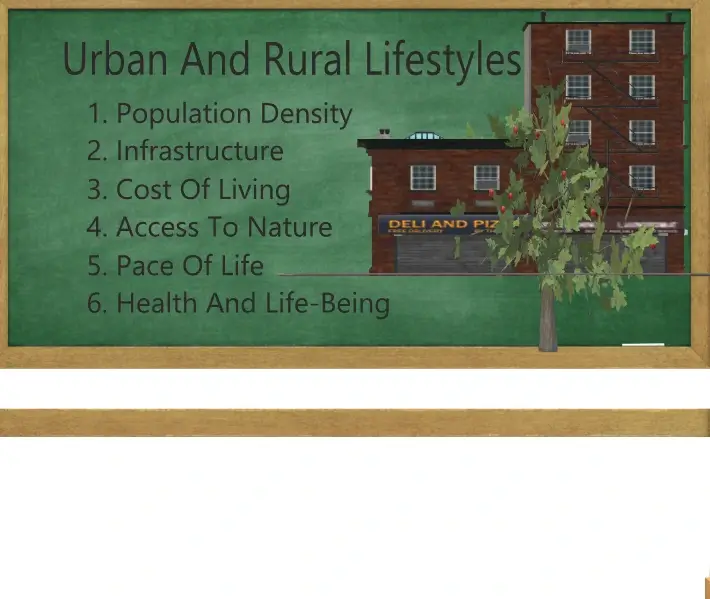A Tale of Two Worlds: Exploring the Urban and Rural Lifestyles
The divide between urban and rural lifestyles has been a constant feature throughout human history. As populations continue to grow, so does the contrast between these two distinct ways of life. Urban and rural environments offer vastly different experiences, shaping the daily routines, values, and perspectives of those who inhabit them. In this article, we will delve into the intricacies of urban and rural lifestyles, exploring the unique characteristics that define each and the factors that contribute to their distinct identities.
Urban Lifestyle:
Urban living is a dynamic and vibrant experience, marked by the hustle and bustle of city life that pulses through the veins of sprawling metropolises. Cities, with their towering skyscrapers and bustling streets, serve as epicenters of economic opportunities, cultural diversity, and a fast-paced lifestyle that captivates millions.
The urban landscape is a testament to human innovation and progress, with skyscrapers reaching for the sky, creating an iconic silhouette against the horizon. The cityscape is not only a manifestation of architectural marvels but also a symbol of relentless ambition and forward-thinking. Each skyscraper tells a story of economic growth, technological advancement, and the pursuit of excellence.
Bustling streets form the arteries of urban areas, teeming with a diverse tapestry of individuals, each contributing to the vibrant mosaic of city life. The constant ebb and flow of people from different walks of life create a dynamic energy that is both invigorating and exhilarating. Streets become the stage for a myriad of activities, from street performances to food markets, further enriching the urban experience.
The allure of urban living extends beyond the physical landscape. Cities are cultural melting pots, attracting individuals from diverse backgrounds, ethnicities, and walks of life. The cultural diversity within city limits is a source of enrichment, offering residents the opportunity to immerse themselves in a kaleidoscope of traditions, languages, and cuisines. Urban centers become canvases where various cultural expressions blend seamlessly, creating a harmonious and vibrant cultural tapestry.
In addition to cultural richness, urban areas boast a plethora of amenities and services that cater to the needs and desires of its inhabitants. Education, healthcare, entertainment, and employment opportunities are often within arm’s reach, creating a convenience that is characteristic of city life. World-class educational institutions, cutting-edge healthcare facilities, theaters, museums, and a spectrum of job options contribute to the allure of urban living.
Residents of urban areas find themselves at the nexus of innovation and progress, with easy access to educational institutions that nurture intellectual growth. Similarly, state-of-the-art healthcare facilities ensure the well-being of city dwellers. Entertainment options, ranging from theaters to music venues and art galleries, cater to diverse tastes, ensuring that urbanites have a plethora of recreational activities at their disposal.
Moreover, urban living is synonymous with employment opportunities across various industries. The city becomes a thriving marketplace for commerce, technology, finance, and more. Career advancement and professional networking flourish in the urban landscape, with businesses and industries concentrated in city centers. The urban professional experience is characterized by a fast-paced lifestyle, where adaptability and innovation are key to thriving in the competitive urban environment.

In short urban living encapsulates a dynamic and multifaceted lifestyle. The towering skyscrapers, bustling streets, and cultural diversity create an environment that fosters economic growth, cultural enrichment, and a fast-paced way of life. The city becomes not just a habitat but a vibrant ecosystem where individuals thrive on the opportunities, challenges, and the electrifying energy that defines urban living.
Career and Economic Opportunities in Urban Areas:
Urban areas serve as dynamic hubs of economic activity, presenting a plethora of career opportunities across a diverse range of industries. The concentration of businesses, corporations, and industries within city limits creates a thriving ecosystem that attracts professionals from various fields.
- Diverse Job Opportunities:
Urban landscapes are teeming with a variety of job opportunities spanning multiple sectors. Industries such as finance, technology, healthcare, media, and manufacturing often establish their headquarters or major operations in urban centers. This diversity allows individuals to explore and pursue careers that align with their skills, interests, and aspirations. - Corporate Concentration:
City centers act as focal points for corporate headquarters, financial institutions, and innovation hubs. The concentration of businesses in these urban cores facilitates collaboration, competition, and the exchange of ideas. As a result, professionals working in urban areas are often at the forefront of industry trends and advancements. - Innovation and Entrepreneurship:
Urban environments foster innovation and entrepreneurship, providing a conducive atmosphere for startups and creative ventures to thrive. The proximity to like-minded professionals, investors, and potential collaborators creates an environment where new ideas can be nurtured and transformed into successful businesses. - Professional Networking:
The close proximity of businesses and professionals in urban areas enhances opportunities for networking. Professionals can attend industry events, conferences, and meet-ups, fostering connections that can lead to career growth, mentorship, and collaborative projects. The interconnectedness of urban professionals contributes to a robust and dynamic professional network. - Career Advancement:
Urban areas offer a conducive environment for career advancement. The competitive nature of the urban job market encourages individuals to continuously improve their skills, stay updated on industry trends, and pursue professional development opportunities. This focus on self-improvement enhances the chances of career progression and success. - Access to Educational and Training Institutions:
Many urban areas host renowned educational and training institutions, providing residents with access to top-notch academic programs and skill development courses. This proximity to educational resources enhances the workforce’s overall skill set and contributes to the continuous growth and adaptability of professionals. - Global Connectivity:
Urban professionals often benefit from global connectivity, as cities are hubs for international business and trade. This global exposure opens up avenues for cross-cultural collaborations, international job opportunities, and a broader perspective on industry practices.
In summary, urban areas are synonymous with an abundance of career and economic opportunities. The concentration of diverse industries, corporate headquarters, and innovative ventures creates an environment where professionals can thrive, continually evolve, and contribute to the economic vitality of the urban landscape. The dynamic nature of urban economies makes them attractive hubs for individuals seeking diverse and rewarding career paths.
Cultural Diversity:
- Cities attract people from different backgrounds, fostering a rich tapestry of cultures, languages, and traditions.
- Urban dwellers have the chance to experience diverse cuisines, art forms, and entertainment options.
Infrastructure and Amenities in Urban Areas:
Urban areas boast advanced infrastructure, providing residents with seamless access to essential services and amenities that contribute to a high quality of life. This well-developed infrastructure is a key characteristic of urban living, encompassing various facets that enhance the convenience and functionality of the city environment.
- Transportation Networks:
Urban areas are characterized by well-established and extensive transportation networks. This includes efficient public transportation systems such as buses, subways, and trains, as well as well-maintained roadways. The accessibility of transportation options ensures that residents can easily navigate the city, reducing commute times and promoting connectivity. - Healthcare Facilities:
The healthcare infrastructure in urban areas is often highly sophisticated, with access to state-of-the-art hospitals, clinics, and medical facilities. Specialized healthcare services, advanced medical technologies, and a concentration of medical professionals contribute to the overall health and well-being of urban residents. - Educational Institutions:
Urban living provides easy access to a diverse range of educational institutions. From primary schools to universities, urban areas host a plethora of learning centers. This concentration of educational facilities allows residents to choose from a variety of schools and universities, catering to different educational needs and preferences. - Recreational Spaces:
Urban planning emphasizes the creation of recreational spaces within the city limits. Parks, gardens, and public spaces provide residents with opportunities for relaxation, exercise, and community engagement. Well-maintained green areas contribute to the overall aesthetic appeal of the urban environment and promote a healthier lifestyle. - Cultural and Entertainment Venues:
Urban areas are rich in cultural and entertainment amenities. The presence of theaters, museums, art galleries, and entertainment venues ensures that residents have access to a diverse range of cultural experiences. This cultural richness contributes to the vibrancy and diversity of urban life. - Commercial and Retail Centers:
Well-developed urban infrastructure includes commercial and retail centers that cater to the diverse needs and preferences of residents. Shopping districts, malls, and markets offer a wide array of products and services, providing convenience and variety for those living in urban areas. - Utilities and Services:
Urban infrastructure includes reliable utilities and services such as water supply, electricity, and waste management. The efficiency of these essential services ensures a comfortable and functional living environment for urban residents.
In summary, the advanced infrastructure in urban areas plays a pivotal role in shaping the lifestyle of its inhabitants. From efficient transportation systems to top-notch healthcare facilities, educational institutions, recreational spaces, and cultural amenities, urban living is characterized by the seamless integration of essential services, contributing to the overall well-being and convenience of those who call the city home.
Social Connectivity:
- The urban lifestyle serves as a vibrant tapestry of social connectivity, where a multitude of events, gatherings, and social spaces weave together to foster interactions among diverse communities. Cities, with their bustling streets and dynamic atmospheres, become platforms for people from various backgrounds to come together, share experiences, and forge connections.
- Events ranging from cultural festivals to community gatherings and social spaces like parks and entertainment venues provide the backdrop for individuals to engage in meaningful interactions. This social vibrancy not only enriches the lives of urban dwellers but also contributes to the cultural diversity and dynamism that define city living. In the urban landscape, the convergence of different communities creates a melting pot of ideas, perspectives, and shared experiences, reinforcing the sense of belonging and interconnectedness within the bustling city life.
Rural Lifestyle:
In contrast to the hustle and bustle of urban life, rural living is distinguished by a more serene and unhurried pace. Characterized by expansive landscapes, close-knit communities, and an intimate connection to nature, rural areas provide a unique and tranquil way of life that stands in juxtaposition to the dynamic energy of cities.
- Slower Pace:
One of the defining features of rural living is the unhurried pace of daily life. Away from the frenetic activity of urban centers, residents in rural areas often experience a sense of calm and simplicity. The rhythm of life is dictated by the changing seasons, agricultural cycles, and the natural ebb and flow of daily tasks. - Close-Knit Communities:
Rural living fosters close-knit communities where neighbors often know each other by name. The smaller population size creates a sense of familiarity and interconnectedness, promoting a supportive and communal atmosphere. Residents in rural areas share a sense of belonging and often come together to celebrate milestones, festivals, and community events. - Connection to Nature:
Perhaps one of the most significant aspects of rural living is the profound connection to nature. Rural areas are characterized by open spaces, sprawling fields, and natural landscapes. Residents often have direct access to the outdoors, allowing for a deep appreciation of the natural world. This connection to nature not only influences the lifestyle but also shapes the values and perspectives of those living in rural communities. - Agricultural Landscapes:
Agriculture is a central component of rural economies, and many residents engage in farming or related activities. The vast expanses of agricultural landscapes define the rural scenery, showcasing fields of crops, pastures, and homesteads. This reliance on agriculture fosters a strong connection to the land and a sustainable way of life. - Sense of Community:
The sense of community in rural areas goes beyond mere acquaintance; it embodies a spirit of mutual support and collaboration. Residents often come together to address common challenges, share resources, and celebrate shared successes. This strong sense of community contributes to the resilience and social fabric of rural life.
In essence, rural living represents a lifestyle characterized by simplicity, community, and a harmonious coexistence with nature. Away from the urban clamor, rural areas offer residents the opportunity to embrace a slower pace of life, build meaningful connections with neighbors, and forge a profound relationship with the natural environment that surrounds them. The idyllic charm of rural living lies in its ability to provide a respite from the complexities of modern urban existence, offering a tranquil haven where the beauty of nature and the warmth of community take center stage.
Factors Influencing Lifestyle Choices Between Urban And Rural Lifestyles
| Factors | Urban Lifestyle | Rural Lifestyle |
|---|---|---|
| Career and Economic | Abundance of job opportunities across various | Limited job options, often centered around |
| Opportunities | industries with potential for career advancement | agriculture, fewer professional networking |
| and professional networking. | opportunities. | |
| Cultural Diversity | Rich cultural diversity due to the convergence | Homogeneous communities with shared traditions |
| of people from different backgrounds. | and values. | |
| Infrastructure and Amenities | Advanced infrastructure offering easy access | Limited access to amenities, reliance on nearby |
| to transportation, healthcare, education, and | towns or cities for services. | |
| recreational facilities. | ||
| Social Connectivity | Numerous events, gatherings, and social spaces | Strong community bonds, interpersonal |
| promoting interactions among diverse communities | relationships within close-knit neighborhoods. | |
| Pace of Life | Fast-paced, dynamic lifestyle with a focus on | Slower pace of life, closer connection to |
| career and personal development. | nature and agricultural cycles. | |
| Access to Nature | Limited access to expansive natural landscapes | Immediate proximity to open spaces, agricultural |
| and greenery, often replaced by urban parks. | landscapes, and natural surroundings. | |
| Cost of Living | Higher cost of living due to expenses associated | Lower cost of living, but potential limitations |
| with urban amenities and housing. | in access to certain services. | |
| Health and Well-being | Access to specialized healthcare facilities and | Greater focus on a wholesome lifestyle, often |
| wellness centers. | with less stress and pollution. |
This table outlines the key factors that differentiate urban and rural lifestyles. While urban living offers diverse career opportunities, cultural richness, and advanced infrastructure, rural living is characterized by strong community bonds, a slower pace of life, and a closer connection to nature. Lifestyle choices are influenced by these factors, shaping the experiences and priorities of individuals in urban and rural environments.
Conclusion:
In the tapestry of human civilization, both urban and rural lifestyles contribute unique threads, weaving together the diverse fabric of our societies. Whether one thrives in the dynamic energy of the city or finds solace in the simplicity of rural life, each lifestyle offers its own set of advantages and challenges. As our world continues to evolve, understanding and appreciating the distinct qualities of urban and rural living become essential for fostering empathy, tolerance, and a shared vision for a harmonious coexistence.






